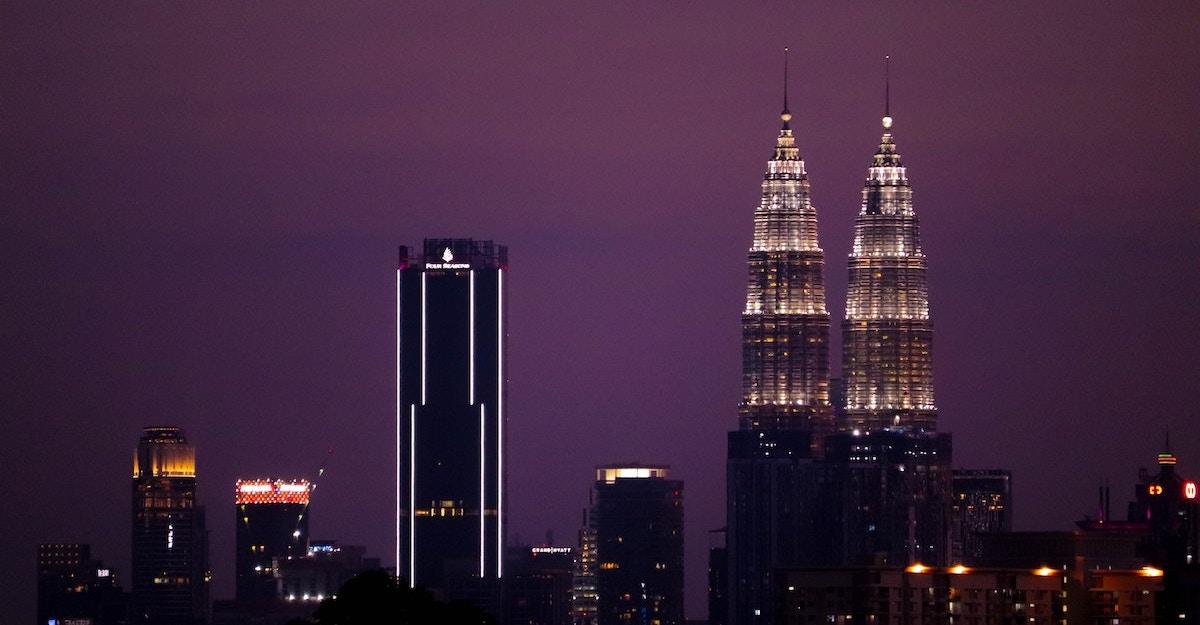Kuala Lumpur Travel Guide
Kuala Lumpur is the bustling capital of Malaysia and its showpiece of grandeur and prosperity. The city's somewhat unromantic name translates as 'muddy confluence', and was given by Chinese prospectors who were searching for tin at the meeting point of the Klang and Gombak rivers in 1857. KL has come a long way since then, with the river water now reflecting the city's elegant, glittering skyscrapers.
Today, Kuala Lumpur is a blend of old and new worlds, where visitors will find a melting pot of Malay, Chinese and Indian cultures. Many begin their adventure in Merdeka Square, which is the heart of the city. The modern business centre and colourful streets of Chinatown lie southeast of the square. Travellers heading south will find the picturesque National Mosque (Masjid Negara) and the impressive railway station. To the west, nature lovers can enjoy the city's green belt, where the lush and tranquil Perdana Botanical Gardens provide some respite from the KL's frenetic pace. The National Museum and (Muzium Negara) and the Malaysian Parliament are also found on this stretch.
Things to do in Kuala Lumpur
Kuala Lumpur is a year-round destination, where the skyline is a contrast of towering contemporary structures and charming heritage buildings. Visitors can enjoy a melting pot of Southeast Asia's traditional cultures and religions, as well as the affluent city's modern attractions.
The iconic Petronas Twin Towers are the world's tallest twin buildings, and Kuala Lumpur's most striking landmark. They're a good place for visitors to begin their sightseeing. The breath-taking National Mosque (Masjid Negara), Friday Mosque (Masjid Jamek) and the intricately ornate, Moorish-style Kuala Lumpur Railway Station carry an old-world charm. Visitors will find more interesting old buildings around Merdeka Square, where Malaysia first declared its independence in 1957. History buffs will love learning about the country's culture and heritage at the National Museum.
Outdoor enthusiasts must venture to the vast Taman Negara national park, which contains some of the world's oldest rainforest. Visitors can spend their time trekking, fishing, river rafting, bird watching or even climbing the peninsula's highest mountain, Gunung Tahan.
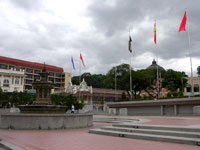
Merdeka Square (Dataran Merdeka)
At 328 feet (100m), the flagpole rising from Merdeka Square is one of the tallest in the world. More importantly, it marks the place where Malaysia achieved independence at midnight on the 31th of August 1957. The square remains the heart of Malaysian nationalism, and one of the few places in Kuala Lumpur where colonial buildings still stand.
The city's colonial past is very much alive in the architecture and large field, which still hosts the occasional cricket match. The Tudor-style Royal Selangor Club rests on one corner of the square, and looks onto a large video screen displaying adverts and religious messages. Once a social centre for Kuala Lumpur's British residents, its doors are now open to anyone who can afford the membership fees. As die-hard custom dictates, women are not allowed to enter the bar save by invitation.
Other buildings of interest around the square include St. Mary's Church, which is supposedly the first church built in the city, and the Abdul Sambad building, which was built for one of the sultans. Travellers will find some shops and restaurants in the area.
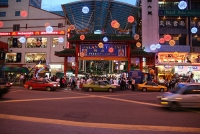
Chinatown
Chinatown is an intoxicating jumble of crowds, colours and authentic food. The central section of Petaling Street is closed at night, when the area is transformed into an exciting, brightly lit shopping experience. Vendors spread their wares onto the pavement, displaying anything from toys to t-shirts and jewellery.
Shoppers will need to be careful, though, as many items are fake. Also, bargaining for the best price is expected and part of the fun. Many stalls operate during the day, but Chinatown is more special at night. Shoppers should be mindful of pick-pockets, regardless of what time of day they visit; culture lovers should note that the area has some tremendous Chinese temples.
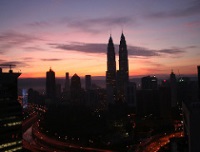
Petronas Towers
The Petronas Towers were designed to capture Malaysia's emergence as Southeast Asia's cultural and commercial centre. Celebrated as the world's tallest twin towers, they dominate the city skyline. Architects followed the traditional geometric principles of Islamic architecture when designing the buildings, using modern technology to stunning effect. Joined by a skybridge on the 41st floor, the towers are used as office complexes that form part of the Kuala Lumpur City Centre Development Park. They're particularly beautiful when lit up at night. Tours include crossing the famous bridge and going up to an observation deck on the 86nd floor, which offers phenomenal, 360-degree views of the city. Visitors can also enjoy an exhibition detailing the development of the towers, and purchase souvenirs at a gift shop.
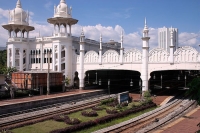
Kuala Lumpur Railway Station
British colonial architect Arthur Benison Hubback was inspired by Moorish, Mughal and Islamic design when he conceived this magnificent railway station. Easily mistaken for a sultan's palace, its arches, spires, towers and minarets dazzle against a backdrop of skyscrapers. Inside, visitors will find a small railway museum on the evolution of railway technology in Malaysia. It may be worth a visit for railway enthusiasts. The Kuala Lumpur Railway Station is more of a landmark than an attraction, though, and should only require a quick walk by and photo shoot.
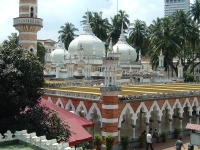
Friday Mosque (Masjid Jamek)
Masjid Jamek (the Friday Mosque) lies where the Klang River meets the Gombak River. Palm trees and curved steps lead to the water's edge, deepening the mosque's air of tranquillity. The site is very much a haven within the buzz and rush of Kuala Lumpur. Visitors will find dazzling photo opportunities amid the combination of ancient Moorish, Islam and Mughal architectural styles, and leafy surroundings. Custom demands that they dress conservatively and remove their shoes on entering. Mosque staff will supply men and women with the appropriate attire if necessary. Masjid Negara (the National Mosque) offers a modern contrast to the Friday Mosque and is also worth visiting. Opened in 1965, it's one of the largest in Southeast Asia.
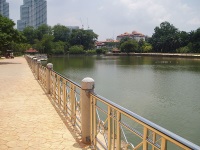
Perdana Botanical Gardens
The beautiful gardens were established in 1888 and are Kuala Lumpur's green belt. To many people, their backdrop of skyscrapers is reminiscent of New York's Central Park. Lush vegetation surrounds a vast lake, where visitors will find a number of romantic bridges and plenty of space to read, jog or socialise. Leisurely boat cruises are also on offer. Regarding attractions, Bird Park, Butterfly House, the National Monument, the Orchid and Hibiscus gardens and Malaysia's Parliament House are all in the area, and children can enjoy some wonderful playgrounds.
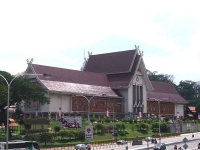
National Museum (Muzium Negara)
Designed to reflect the region's Minangkabau architectural style, the National Museum houses many of Malaysia's cultural treasures and historical artefacts. Its ethnographic and archaeological exhibits include life-size dioramas of traditional Malaysian life.
Puppet-shadow-play (wayang kulit) displays show the country's ancient artistry, while exhibits of traditional weapons such as daggers (kris) and machetes (parangs) reveal Malaysia's pride in functional aesthetic forms. Travellers should note that the museum covers a lot of time and subject matter, and suffers from an occasional lack of linkage between periods. For this reason, visitors should join one of the free guided tours.
Photography is permitted, though only with a hand-held camera and for private use; visitors will find a shop and cafeteria, and features for disabled guests.
Things to do with kids in Kuala Lumpur
Kuala Lumpur's playgrounds, attractions and shopping malls make it a wonderfully child-friendly destination. Parents may want to begin their sightseeing at the Petronas Towers, which offer breath-taking views of the city. The Perdana Botanical Gardens are worth visiting too, as kids will find plenty of wide open spaces to play in. The sight also has some lovely picnic spots, and is home to the Bird Park and Butterfly House.
Other child-friendly activities include looking at toys in Chinatown, or walking through the vast Taman Negara national park. If the temperature climbs too high, children will enjoy any one of Kuala Lumpur's many water parks. When the sun goes down, parents can treat kids to the unique and unforgettable Fireflies Tour, which takes visitors down the Selangor River by boat to watch fireflies lighting up the mangrove trees.

Chinatown
Chinatown is an intoxicating jumble of crowds, colours and authentic food. The central section of Petaling Street is closed at night, when the area is transformed into an exciting, brightly lit shopping experience. Vendors spread their wares onto the pavement, displaying anything from toys to t-shirts and jewellery.
Shoppers will need to be careful, though, as many items are fake. Also, bargaining for the best price is expected and part of the fun. Many stalls operate during the day, but Chinatown is more special at night. Shoppers should be mindful of pick-pockets, regardless of what time of day they visit; culture lovers should note that the area has some tremendous Chinese temples.

Petronas Towers
The Petronas Towers were designed to capture Malaysia's emergence as Southeast Asia's cultural and commercial centre. Celebrated as the world's tallest twin towers, they dominate the city skyline. Architects followed the traditional geometric principles of Islamic architecture when designing the buildings, using modern technology to stunning effect. Joined by a skybridge on the 41st floor, the towers are used as office complexes that form part of the Kuala Lumpur City Centre Development Park. They're particularly beautiful when lit up at night. Tours include crossing the famous bridge and going up to an observation deck on the 86nd floor, which offers phenomenal, 360-degree views of the city. Visitors can also enjoy an exhibition detailing the development of the towers, and purchase souvenirs at a gift shop.

Perdana Botanical Gardens
The beautiful gardens were established in 1888 and are Kuala Lumpur's green belt. To many people, their backdrop of skyscrapers is reminiscent of New York's Central Park. Lush vegetation surrounds a vast lake, where visitors will find a number of romantic bridges and plenty of space to read, jog or socialise. Leisurely boat cruises are also on offer. Regarding attractions, Bird Park, Butterfly House, the National Monument, the Orchid and Hibiscus gardens and Malaysia's Parliament House are all in the area, and children can enjoy some wonderful playgrounds.
Eating Out
Kuala Lumpur is an exotic garden of flavours, where travellers can indulge in a wide variety of the region's most delectable cuisines. Visitors will find thousands of roadside stalls and food bazaars that cater to all kinds of tastes and budgets. Popular bites include satay (marinated and barbecued meat, normally chicken, beef or mutton), nasi lemak (savoury rice steamed in coconut milk) and chicken rice and fried noodles.
Indigenous Malaysian cuisine is influenced by Thai, Indian and Chinese cooking, and offers exciting flavours. Indian Muslim (Mamak) cuisine is especially fragrant, with spices, curry leaves, and coconut milk characterising its dishes. Malaysian Chinese food is also widely loved, and remains distinctly Chinese.
Shopping
Kuala Lumpur is Malaysia's retail, fashion and electronics centre. The Golden Triangle is the city's premier shopping area, where visitors can pick up high-end items produced by the most sought-after brands. Bukit Bintang Street is the best place to start spending. The Suria KLCC is another of the country's most famous shopping spots, given its location beneath the iconic Petronas Towers.
The Central Market on Jalan Hang Kasturi is a great place to buy anything from antiques and paintings to handicrafts, clothing and quirky souvenirs. Best buys include pottery, woodcarvings, and brass, pewter and silver jewellery. Visitors can also walk across to nearby Chinatown to purchase dried food, jewellery and herbal medicines, among other things. They'll need to embrace haggling, though, as it is very much part of the culture.
Nightlife
Pubs, bustling bars, pumping clubs and karaoke lounges offer lots of after-dark entertainment in a city that never sleeps. Visitors will find one of Asia's best nightlife scenes when they explore Malaysia's capital and, though Kuala Lumpur is predominantly Muslim, its cosmopolitan nature allows for alcohol to be widely available.
The city centre has some of KL's trendiest clubs and most eccentric bars. Bukit Bintang is another of the city's most popular areas for nighttime entertainment, where visitors can dine at great restaurants or enjoy vibrant bars.
Tourists looking for a quieter night out should stop at a karaoke bar: a staple in Malaysian society. Singing is entirely optional and it's great fun to simply watch. Local theatres and cabarets are also an option, and cinemas show contemporary English, Malay, Chinese, Hindi and Indonesian movies.
Getting Around
The easiest way to get around Kuala Lumpur is on the five different commuter train routes, each operated by a different company. The KL Monorail serves the main shopping and hotel districts, while the LRT serves Chinatown. Fares are reasonable and the trains are frequent on all routes, operating from about 5.30am to midnight.
City buses are hot, crowded and totally unreliable. Taxis can be hailed at the roadside or found at obvious locations outside hotels, shopping centres and the like. Metered fares rise steeply between midnight and 6am, and drivers sometimes raise the price during peak hours or in bad weather; taxi apps include Grab and Easy Taxi. Hiring a car and self-driving is not recommended in Kuala Lumpur as the traffic is stressful and confusing and public transport is more than sufficient.
Kuala Lumpur Climate and Weather
Kuala Lumpur's climate is typically tropical, meaning it's hot and humid all year round, with no distinct seasons and very little variation in temperature. The mercury hovers in the region of 86F (30C) all year, but can reach around 95F (35C).
Rainfall in the city is heavy and storms occur year-round, usually in the late afternoon. The showers often come as a relief to visitors who are unaccustomed to the heat, and don't generally disrupt itineraries very much, provided that visitors carry a lightweight rain jacket at all times.
Another balm for the heat is the amount of air-conditioned buildings visitors will spend time in; Kuala Lumpur is a modern city and well equipped to handle its tropical climate. June, July and August receive slightly less rainfall on average and, for this reason, many recommend them as the best months to visit the city.
Malaysia travel info
Electricity
The electrical current is 240 volts, 50Hz. UK-style three-pin plugs are used.
Language
Bahasa Melayu is the national language, but English is widely spoken and is the language of business. Mandarin, Cantonese, Hokkien and Hakka are spoken by the Malaysian Chinese population and Tamil, Malayalam and Hindi among the Indian population.
Money
The official currency is the Malaysian ringit (MYR), also referred to as the Malaysian dollar, which is divided into 100 sen. Money changers are generally quicker to deal with than banks and do not charge commission; their rates however are variable. British pounds or US dollars are the easiest to exchange. All major credit cards are accepted at upmarket hotels, shops and restaurants. ATMs are widely available.
Tipping
Although tipping is not customary in Malaysia, the more expensive hotels and restaurants add a 10 percent service charge to their bills and further gratuity is unnecessary. All hotel rooms are subject to a six percent government tax, though many cheaper hotels quote a price inclusive of this tax.
Health
Some tropical illnesses are prevalent in Malaysia and travellers should seek medical advice regarding any recommended vaccinations before travelling. Hepatitis A and hepatitis B are common, as is dengue fever.
Malaria risks are isolated to the inland regions; the exception is Sabah, where there is a year-round risk. Travellers who are arriving from or have transited through infected areas require a yellow fever vaccination certificate.
Visitors may also be advised to get vaccinations for rabies, typhoid and Japanese encephalitis, depending on their travel itineraries in Malaysia. It's best to drink bottled water and avoid uncooked meat, fish and vegetables, unpeeled fruit, ice and salads.
A further health hazard in Malaysia is smoke haze and air pollution, particularly in Kuala Lumpur, which has some of the poorest air quality in Asia. The very high Benzene pollution levels could aggravate cardiac or respiratory problems. Hospitals in Kuala Lumpur and other major Malaysian cities are of a high standard but medical facilities may be lacking in rural areas. Comprehensive medical insurance is recommended.
Safety
Malaysia is a generally safe travel destination, but visitors should nevertheless take normal precautions against crime. They should stay alert and avoid displaying conspicuous wealth, and should also be wary of petty crimes such as bag-snatching and pick-pocketing. Tourists should use hotel safes and duplicate travel documents. Remote parts of eastern and northern Sabah carry some threat of kidnappings by militant Filipino groups.
Local customs
Malaysia is largely Muslim and so Islamic customs should be respected, especially during the month of Ramadan when eating, drinking and smoking in public should be avoided, as it is forbidden by Islamic law. Dress, particularly for women, should be conservative, and arms and legs should be covered when visiting places of worship. It is customary to remove shoes before entering homes and places of worship. When eating or exchanging money, the right hand is used. Homosexuality is illegal.
Doing business
Those looking to do business in Malaysia are strongly urged to research some of the cultural complexities of the country, which is home to different ethnic groups. Although the Malaysian business world has largely succeeded in establishing a unified ethos for itself, it is important to understand that visitors might deal with people from different ethnic groups (Malay, Chinese and Indian being the most common), and that their expectations and conduct might need to adjust accordingly. The defining characteristic of business culture in Malaysia is respect for, and deference to authority. Authority figures are identified more by skills, wisdom and temperament, than by powerful positions and strict hierarchy.
The Malaysian style of management, it follows, is less goal-driven, and more holistic, than in some Western cultures, with managers taking a personal interest in the well-being of their employees. Business etiquette in Malaysia is marked by sensitivity and diplomacy. The golden rule is never to cause another to 'lose face' in professional company; the wilful, or even careless, humiliation of even a subordinate, is considered anathema in the Malaysian business world. Business meetings in Malaysia usually convene punctually, but can be subject to a lot of 'small talk' and personal digressions. Attendees shouldn't get impatient, as this is seen as an important function of meetings in Malaysia, where the agenda is not always as important as the relationships between people that meetings serve to develop.
Business cards are usually exchanged upon meeting new associates. People give and receive cards with their right hand, supported by the left, and never fold or put away a card without looking at it first. Details are printed in Chinese on the reverse side of cards. The dress code for business is typically Western, with smart, formal clothes being worn. Men generally wear white shirts and ties (jackets to be worn to meetings); while women, since Malaysia has a large Muslim population, should dress more conservatively than they might be used to doing at home. English is widely spoken in Malaysia, and commonly used in most businesses. Business hours are generally Monday to Friday, from 9am to 5pm.
Duty free
Travellers to Malaysia do not have to pay customs duty on 200 cigarettes, 50 cigars or 225g tobacco; 1 litre wine, spirits or malt liquor; cosmetic products to the value of RM 200; up to three new items of clothing and one pair of footwear; one portable electrical or battery-operated appliance for personal hygiene; food preparations to the value of RM 75; other goods to the value of RM 400 (with the exception of goods from Langkawi and Labuan, to the value of RM 500). Prohibited items include goods from Haiti, counterfeit money and illegal drugs.
Communications
The international access code for Malaysia is +60. International Direct Dial is available throughout the country, but the service can be erratic. Hotels can add a hefty surcharge to their telephone bills; it is best to check before making international calls. Cafes, hotels and restaurants offer free WiFi in most tourist areas. Buying a local SIM card is a cheaper alternative to using international roaming; travellers can use eSIMs if their cellular providers support it on their networks.
Passport & Visa
Foreign passengers to Malaysia are required to hold return or onward tickets, and the necessary travel documentation for their next destination. A yellow fever vaccination certificate is required to enter Malaysia if travellers are arriving from or have transited through an infected area. It is highly recommended that visitors' passports have at least six months' validity remaining after the intended date of departure from their travel destination. Immigration officials often apply different rules to those stated by travel agents and official sources.
Entry requirements
US citizens must have a passport that is valid for at least six months beyond the date of their arrival in Malaysia. No visa is required for stays of up to 90 days.
UK citizens must have a passport that is valid for at least six months beyond the date of their arrival in Malaysia. No visa is required for stays of up to 90 days.
Canadian citizens must have a passport that is valid for at least six months beyond the date of their arrival in Malaysia. No visa is required for stays of up to 90 days.
Australian citizens must have a passport that is valid for at least six months beyond the date of their arrival in Malaysia. No visa is required for stays of up to 90 days. Note that visa exemptions apply to holders of an APEC business travel card, provided that the back of the card states that it is valid for travel to Malaysia.
South African citizens must have a passport that is valid for at least six months beyond the date of their arrival in Malaysia. No visa is required for stays of up to 90 days.
Irish citizens must have a passport that is valid for at least six months beyond the date of their arrival in Malaysia. No visa is required for stays of up to 90 days.
New Zealand citizens must have a passport that is valid for at least six months beyond the date of their arrival in Malaysia. No visa is required for stays of up to 90 days. Note that visa exemptions apply to holders of an APEC business travel card, provided that the back of the card states that it is valid for travel to Malaysia.
Useful contacts
Malaysian Tourist Website: www.tourism.gov.my
999Embassies / consulates in other countries
Malaysian Embassy, Washington DC, United States: +1 202 572 9700.
Malaysian Embassy, London, United Kingdom: +44 20 7235 8033.
Malaysian High Commission, Ottawa, Canada: +1 613 241 5182.
Malaysian High commission, Canberra, Australia: +61 2 61 200 300.
Malaysian High Commission, Pretoria, South Africa: +27 12 342 5990.
Malaysian Embassy, Dublin, Ireland: +353 1 667 7280.
Malaysian High Commission, Wellington, New Zealand: +64 4 385 2439.
Embassies / consulates in Malaysia
United States Embassy, Kuala Lumpur: +60 3 2168 5000.
British High Commission, Kuala Lumpur: +60 3 2170 2200.
Canadian High Commission, Kuala Lumpur: +60 3 2718 3333.
Australian High Commission, Kuala Lumpur: +60 3 2146 5555.
South African High Commission, Kuala Lumpur: +60 3 2170 2400.
Irish Embassy, Kuala Lumpur: +60 3 2167 8200.
New Zealand High Commission, Kuala Lumpur: +60 3 2078 2533.


